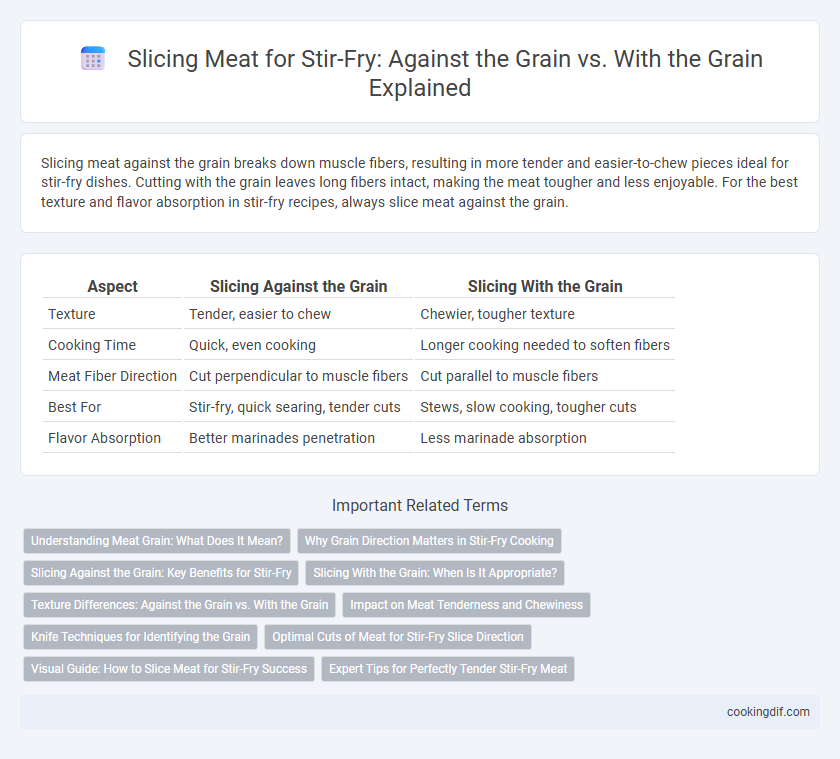Slicing meat against the grain breaks down muscle fibers, resulting in more tender and easier-to-chew pieces ideal for stir-fry dishes. Cutting with the grain leaves long fibers intact, making the meat tougher and less enjoyable. For the best texture and flavor absorption in stir-fry recipes, always slice meat against the grain.
Table of Comparison
| Aspect | Slicing Against the Grain | Slicing With the Grain |
|---|---|---|
| Texture | Tender, easier to chew | Chewier, tougher texture |
| Cooking Time | Quick, even cooking | Longer cooking needed to soften fibers |
| Meat Fiber Direction | Cut perpendicular to muscle fibers | Cut parallel to muscle fibers |
| Best For | Stir-fry, quick searing, tender cuts | Stews, slow cooking, tougher cuts |
| Flavor Absorption | Better marinades penetration | Less marinade absorption |
Understanding Meat Grain: What Does It Mean?
Understanding meat grain is essential for perfect stir-fry results, as it refers to the direction of muscle fibers in the meat. Slicing against the grain means cutting perpendicular to these fibers, which shortens them and creates tender, easy-to-chew pieces. Slicing with the grain leaves long fibers intact, resulting in tougher, chewier meat that is less ideal for stir-fry dishes.
Why Grain Direction Matters in Stir-Fry Cooking
Slicing meat against the grain in stir-fry cooking shortens muscle fibers, resulting in a more tender and easily chewable texture. Cutting with the grain leaves fibers long and tough, making the meat harder to bite and less enjoyable. Understanding grain direction ensures optimal tenderness, enhancing flavor absorption and overall stir-fry quality.
Slicing Against the Grain: Key Benefits for Stir-Fry
Slicing against the grain in stir-fry ensures the meat remains tender by cutting through muscle fibers, reducing chewiness and enhancing texture. This method allows for quicker, more even cooking, preserving juiciness and flavor in each bite. Properly sliced meat against the grain maximizes tenderness and creates a superior stir-fry experience with consistent, melt-in-your-mouth results.
Slicing With the Grain: When Is It Appropriate?
Slicing meat with the grain is appropriate for tougher cuts like brisket or flank steak that benefit from longer fibers maintaining structural integrity during cooking. This method preserves chewiness and is ideal when slow-cooked or braised, allowing the meat to retain juiciness and flavor. For stir-fry, where tenderness is key, slicing against the grain is usually preferred unless a specific texture is desired.
Texture Differences: Against the Grain vs. With the Grain
Slicing meat against the grain breaks down muscle fibers, resulting in tender and easier-to-chew pieces essential for stir-fry dishes. Cutting with the grain keeps longer muscle fibers intact, creating chewier, tougher bites that may detract from the desired stir-fry texture. For optimal tenderness and juiciness in stir-fry, always slice meat against the grain to enhance mouthfeel and flavor absorption.
Impact on Meat Tenderness and Chewiness
Slicing meat against the grain shortens muscle fibers, resulting in enhanced tenderness and reduced chewiness, making each bite easier to chew in stir-fry dishes. Conversely, slicing with the grain maintains longer muscle fibers, which can lead to tougher, chewier meat that requires more effort to eat. For optimal stir-fry texture, cutting against the grain is crucial to achieve a tender and succulent bite.
Knife Techniques for Identifying the Grain
Slicing against the grain of meat involves cutting perpendicular to the muscle fibers, resulting in shorter fibers that enhance tenderness and ease of chewing in stir-fry dishes. Identifying the grain requires inspecting the direction of the muscle fibers' alignment and using a sharp knife to make clean, precise cuts that preserve the meat's texture. Mastery of knife techniques for slicing with or against the grain directly impacts the flavor absorption and mouthfeel of stir-fried meat preparations.
Optimal Cuts of Meat for Stir-Fry Slice Direction
Slicing meat against the grain in stir-fry ensures tender, easy-to-chew bites by cutting through muscle fibers, while slicing with the grain yields tougher, chewier pieces. Optimal cuts like flank, skirt, or sirloin steak benefit most from slicing against the grain for maximum tenderness and flavor absorption. Maintaining a consistent thin slice aligns with high-heat, quick-cooking stir-fry techniques, enhancing texture and overall dish quality.
Visual Guide: How to Slice Meat for Stir-Fry Success
Slicing meat against the grain produces tender, easy-to-chew pieces essential for stir-fry, while cutting with the grain results in tougher, stringy strips that can hinder texture. Identifying muscle fibers visually--long lines running through the meat--helps determine the grain's direction to ensure precise cuts. Using sharp knives to slice thinly across these fibers enhances flavor absorption and cooking speed, perfecting stir-fry outcomes.
Expert Tips for Perfectly Tender Stir-Fry Meat
Slicing meat against the grain shortens muscle fibers, resulting in more tender bites, which is crucial for stir-fry dishes requiring quick cooking at high heat. Cutting with the grain leaves fibers longer and can lead to tougher, chewier texture, detracting from the desired tenderness. Expert chefs recommend using a sharp knife to slice thinly against the grain for optimal tenderness and flavor absorption in stir-fry recipes.
Slicing against the grain vs With the grain for meat Infographic

 cookingdif.com
cookingdif.com